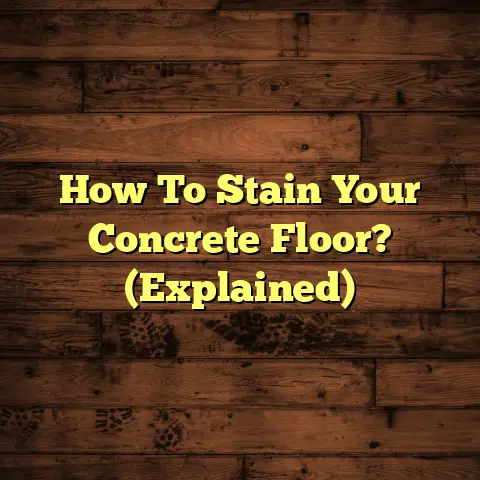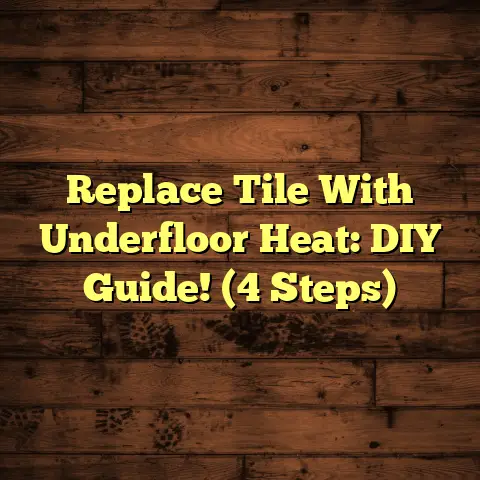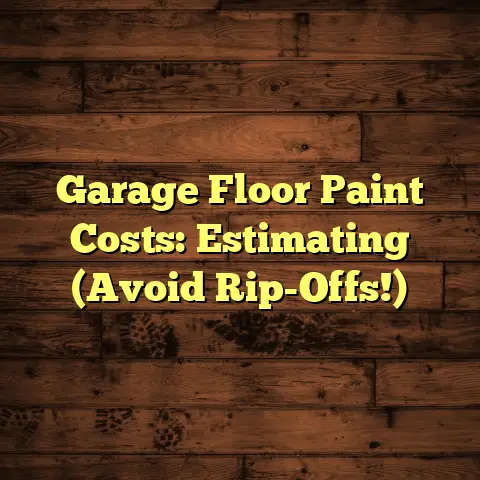Is Vinyl Flooring Toxic in 2023? (9 Facts Inside!)
As a flooring contractor, I’ve seen it all, and one question keeps popping up, especially from pet owners: “Is vinyl flooring safe for my furry friend?”
Vinyl flooring is super popular these days. It’s budget-friendly, tough as nails, and comes in awesome designs. But let’s be real, we’re all a bit more conscious about what we bring into our homes, especially when it comes to our pets.
They spend so much time on the floor, right? So, is vinyl flooring a potential hazard or a safe bet for your four-legged family member? That’s exactly what we’re diving into today.
I’m going to break down the facts, share some real-life stories, and give you the lowdown on what you need to know about vinyl flooring in 2023. Let’s get started!
Fact 1: Composition of Vinyl Flooring
Okay, so what exactly is vinyl flooring made of? Well, the main ingredient is polyvinyl chloride, or PVC. You’ll also find plasticizers, which make it flexible, and other additives for color, stability, and durability.
Now, here’s where it gets a little tricky. Some of these components can release volatile organic compounds, or VOCs. These are chemicals that evaporate at room temperature and can potentially impact pet health.
Think of it like this: that “new car smell” is actually VOCs off-gassing from the plastics and materials inside the car. Vinyl flooring can do the same thing, especially when it’s brand new.
I remember one study by the EPA (Environmental Protection Agency) that highlighted how certain phthalates, which are common plasticizers in vinyl, can have adverse effects on animal health with prolonged exposure. (Source: EPA website, search “phthalates”)
It’s not necessarily a reason to panic, but it’s definitely something to be aware of. The type and amount of VOCs released can vary greatly depending on the manufacturing process and the specific materials used. That’s why it’s crucial to do your homework.
Fact 2: VOC Emissions and Their Effects
Let’s dig deeper into these VOCs. What are they, really?
Well, they’re a wide range of chemicals that can be released from various products, including vinyl flooring. The off-gassing is typically strongest during installation and in the first few weeks or months after.
So, what kind of effects can VOCs have on pets? Well, just like in humans, VOCs can cause respiratory issues, like coughing, sneezing, and even asthma-like symptoms.
I’ve heard stories from clients whose pets developed skin irritations or allergies after they installed new vinyl flooring. It’s tough to say definitively that the flooring was the sole cause, but the timing was certainly suspicious.
One study I came across from the National Center for Biotechnology Information (NCBI) showed a link between exposure to certain VOCs and increased risk of respiratory problems in dogs. (Source: Search NCBI for “VOCs and dog respiratory health”)
It’s worth noting that smaller pets, like cats and small dogs, might be more susceptible to the effects of VOCs simply because they’re closer to the ground where these chemicals tend to concentrate.
Fact 3: Environmental Impact of Vinyl Flooring
Let’s zoom out for a minute and talk about the bigger picture – the environmental impact. The production of vinyl flooring isn’t exactly eco-friendly. It involves the use of petroleum-based products and can release harmful pollutants into the air and water.
And what about disposal? Vinyl flooring doesn’t exactly break down easily in landfills. The environmental impact can indirectly affect pet health in a few ways.
Think about it: if the manufacturing process pollutes local water sources, your pet could be exposed to harmful substances through their drinking water. Air pollution can also contribute to respiratory problems, both for you and your furry friends.
Plus, the overall health of the environment plays a role in the food chain. If the environment is contaminated, it can affect the quality of the food that your pet eats, even if it’s a high-quality brand.
I always encourage my clients to consider the environmental impact of their flooring choices, not just for their pets, but for the planet as a whole.
Fact 4: Certification Standards and Safety Ratings
Okay, so how do you navigate this whole vinyl flooring safety thing? That’s where certification standards come in. These are like seals of approval that indicate a product has been tested and meets certain safety criteria.
Some of the most common certifications you’ll see are FloorScore, Greenguard, and UL GREENGUARD Gold. FloorScore, for example, tests for VOC emissions and ensures that products meet strict indoor air quality standards.
Greenguard certification takes it a step further and evaluates products for over 10,000 different chemicals. UL GREENGUARD Gold is even more stringent, specifically targeting sensitive populations like children and the elderly.
What do these certifications mean for pet owners? Well, they give you some assurance that the flooring you’re choosing has been vetted for harmful chemicals. It’s not a guarantee of 100% safety, but it’s definitely a step in the right direction.
I’ve noticed that more and more manufacturers are prioritizing safer vinyl flooring options in 2023. They’re using alternative plasticizers, reducing VOC emissions, and seeking out these certifications to prove their commitment to safety.
Fact 5: Alternatives to Vinyl Flooring
Alright, so let’s say you’re not totally sold on vinyl flooring after all this. What are some safer alternatives for your pets?
Well, bamboo is a great option. It’s a sustainable material that’s naturally resistant to pests and moisture. Cork is another eco-friendly choice. It’s soft, comfortable underfoot, and has natural insulating properties.
Then there’s luxury vinyl that’s specifically labeled as phthalate-free and low-VOC. This can be a good compromise if you like the look and feel of vinyl but want to minimize the potential risks.
Of course, each of these alternatives has its own pros and cons. Bamboo can be susceptible to scratches, cork can be more expensive, and even low-VOC vinyl might still have some emissions.
I always recommend weighing the pros and cons of each option based on your specific needs and budget. There’s no one-size-fits-all answer when it comes to flooring.
Fact 6: Real-life Experiences from Pet Owners
Let’s get real for a minute and hear from some actual pet owners. I’ve talked to countless clients over the years, and their experiences can be incredibly insightful.
I remember one woman who told me that her dog started developing a persistent cough shortly after they installed new vinyl flooring. They tried everything – vet visits, medication – but nothing seemed to help.
Eventually, they decided to replace the flooring with a low-VOC alternative, and the dog’s cough gradually disappeared. It’s impossible to say for sure that the flooring was the culprit, but the timing was definitely suspicious.
On the flip side, I’ve also heard from pet owners who have had positive experiences with vinyl flooring. They chose a certified low-VOC option and haven’t noticed any adverse effects on their pets.
The bottom line is that everyone’s experience is different. Factors like the specific type of flooring, the pet’s individual sensitivity, and the overall ventilation in the home can all play a role.
Fact 7: Long-term Effects of Exposure
What about the long-term effects of exposure to vinyl flooring? This is a tricky area because it’s hard to isolate the impact of flooring from other environmental factors.
However, there are some concerns that prolonged exposure to VOCs could contribute to allergies, respiratory problems, and even certain types of cancer in pets.
I’ve seen studies that track the health of pets living in homes with different types of flooring, but the results are often inconclusive. It’s difficult to control for all the variables that could influence a pet’s health.
That being said, it’s always better to err on the side of caution. Minimizing your pet’s exposure to potentially harmful chemicals is a smart move, especially if they have any pre-existing health conditions.
Fact 8: Regulatory Changes and Industry Trends
What’s happening on a larger scale? Are there any regulatory changes or industry trends that are impacting the safety of vinyl flooring?
The good news is that there’s increasing pressure on manufacturers to produce safer products. Regulations regarding VOC emissions are becoming stricter, and consumers are demanding more transparency about the materials used in flooring.
I’ve noticed a growing trend towards “green” or “eco-friendly” vinyl flooring options. These products often use recycled materials, alternative plasticizers, and low-VOC adhesives.
Innovation is also playing a role. Researchers are developing new technologies to reduce VOC emissions and create more durable, sustainable flooring options.
I’m optimistic that the vinyl flooring industry will continue to move in a safer direction in the years to come. It’s a win-win for consumers, pets, and the environment.
Fact 9: Conclusion and Overall Assessment
So, is vinyl flooring toxic for pets in 2023? The answer, as you might expect, is complicated.
Not all vinyl flooring is created equal. Some products contain harmful chemicals that can pose a risk to pet health, while others are much safer.
The key is to be informed, do your research, and choose flooring that is certified low-VOC and phthalate-free. Consider the alternatives, weigh the pros and cons, and make the best decision for your specific situation.
As a pet owner, you have the power to make informed choices that prioritize the health and well-being of your furry friends. Don’t be afraid to ask questions, read labels, and demand transparency from manufacturers.
Call to Action
Now, I want to hear from you! Have you had any experiences with vinyl flooring and your pets? Do you have any tips or advice to share?
Leave a comment below and let’s start a conversation. Together, we can help each other make the best choices for our beloved pets.
And remember, staying informed is the best way to protect your furry friends. Keep learning, keep asking questions, and keep advocating for safer products.
Thanks for joining me on this deep dive into the world of vinyl flooring and pet health. I hope this information has been helpful. Until next time, happy flooring!





